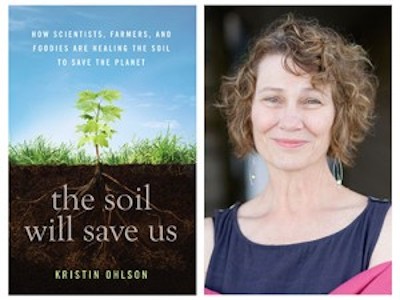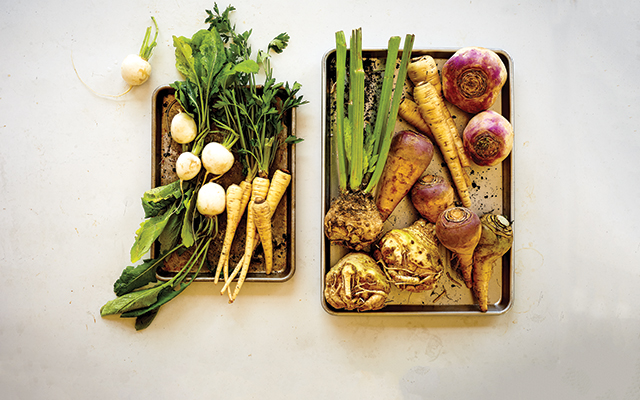You probably don’t give much thought to the soil in which your food grows. But if you care about the nutritional value of your tomatoes, potatoes and peas — and, more generally, if you care about your health — that dirt probably deserves a good deal more consideration than it’s currently getting.
New studies are confirming what soil-savvy farmers have suspected for years: The nutrient levels in food are directly linked to the nutrient levels in soil. “Human health and soil health are one and the same,” says Elaine Ingham, PhD, a soil microbiologist and founder of Soil Foodweb, a Corvallis, Ore., company that specializes in testing the living components of soil. “Everything goes back to the soil.”
The Connection Between Soil Quality and Nutrient-Rich Food
To understand the interconnectedness of soil quality and food nutrients, it helps to know some basic soil biology. For instance, just 1 teaspoon of healthy, untouched prairie soil houses up to 800 million individual bacteria, 10,000 protozoa, 30 different beneficial nematodes and several miles of fungi strands.
That microbial menagerie is the foundation of healthy soil. Organisms near the surface speed up the decay of organic matter, like dried leaves and crop leftovers. The ensuing rot nourishes the soil down below, infusing growing plants with vitamins and minerals. Meanwhile, larger organisms, like earthworms, create good soil structure by tunneling through the soil. This entire underground zoo, from bacteria to moles, makes up the soil’s biology and creates a light and airy soil through which water and air can move freely, says Ingham.
Most organic farmers are passionate about their soil’s biology. Take Zoë Bradbury. The 28-year-old farmer grows everything from berries to beets on the small farm she works with her mother and sister in Langlois, Ore. During the off-season, she replenishes the soil by practicing the age-old method of cover cropping: planting grasses, legumes and other vegetative matter to infuse nutrients into the soil, reduce erosion and boost organic matter.
She laughingly admits she likes to grow cover crops more than her cash crops: “There is just something that feels so good about bringing up a lush, healthy stand of buckwheat or rye and knowing the crop is feeding the ecosystem beneath the surface,” she says. “What’s going on in the soil is so complex, it’s almost like magic to me; it would be egotistical to assume we could map out how it all works.”
Modern Farming’s Impact on Soil Quality and Nutrition
Ironically, as science has attempted to “improve” traditional, nature-inspired soil-management strategies, the quality of farmed soils has tended to suffer. Today, nearly 95 percent of American farmland is conventionally farmed, leaning heavily on chemical fertilizers: specifically, three major plant nutrients (nitrogen, phosphorus and potassium) that encourage growth, but can simultaneously downgrade the crop’s nutrient potential.
Pesticides also can upset the balance of plant nutrients and phytochemicals, including antioxidants, which plants develop to help ward off pests and other stressors. Dousing plants with pesticides suppresses the pests as well as the beneficial phytonutrients.
But chemicals are only partially to blame for poor soil quality. Other soil robbers, such as monocropping and the use of genetically modified organisms (GMOs), are common practices on today’s super-sized farms. Monocropping involves planting the same crop in the same field season after season. Because monocrop growers do not rotate crops — a practice that naturally fertilizes soil by exposing it to different plants, and, thus, diverse nutrients — they must rely on chemical fertilizers to encourage growth. With each passing year, the soil becomes more nutrient-poor, requiring the grower to apply an increasing amount of chemicals to keep crop yields steady.
Most GMOs prioritize quantity over quality, food producers yield more abundant crops (and profits), but in many cases, consumers end up with fewer nutrients.
GMOs deepen nutritional deficits in a different way. Because most GMOs prioritize quantity over quality, food producers yield more abundant crops (and profits), but in many cases, consumers end up with fewer nutrients. “We find some genetically modified crops are deficient in micronutrients, either due to genetics or the chemicals used on them to control weeds,” says USDA microbiologist Robert Kremer, PhD.
Unlike the traditional seed-selection techniques employed by farmers who wanted to emphasize a given plant’s best naturally occurring characteristics, today’s plant breeding has focused on traits such as yield, appearance and pest resistance. “Modern plant breeding hasn’t focused on nutritional quality,” says Craig Cogger, PhD, a soil scientist at Washington State University, in Pullman, Wash., “and, if you don’t focus on a trait, it tends to decline.”
One of the other long-term concerns about GMOs is how they contribute to soil degradation. For instance, many GMOs are designed to grow closer together to increase a crop’s yield per acre. Angie Tagtow, MS, RD, LD, a dietitian and managing editor of the Journal of Hunger & Environmental Nutrition, likens the practice of jamming too many plants into the soil to that of raising cattle on feedlots: In the end, there just aren’t enough resources to go around. “By putting them in a more confined space, they must compete for those things that enable them to mature, like nutrients, water and sunlight,” she says, “all of which take a toll on the soil.”
The Alarming Decline in Nutritional Value:
The result of lackluster soil-management practices has been a precipitous drop in the nutritional value of the foods we eat every day. A 2004 study by a team of scientists from Kansas and Texas used data from the USDA’s archives to evaluate the nutrient content of 43 fruits and vegetables grown in 1950 and compared them with the identical fruits and veggies grown in 1999. Their findings were disturbing: Levels of calcium were down 16 percent, iron 15 percent and vitamin C 20 percent. Not a single nutrient had increased in the past 50 years.
In a more recent study, published in March in the plant physiology journal Euphytica, researchers at Washington State University compared 63 spring wheat cultivars grown between 1842 and 2003 and found double-digit drops in the concentrations of several minerals, including an 11 percent dip in iron, a 16 percent drop in copper, a 25 percent decline in zinc and a 50 percent loss of selenium.
“The problem is that farmers are paid for quantity, not quality,” says Charles Benbrook.
“The problem is that farmers are paid for quantity, not quality,” says Charles Benbrook, chief scientist at The Organic Center, a Boulder, Colo., nonprofit organization that supports the scientific study of organic farming.
This arrangement produces a dangerous cycle: Farmers use excess nitrogen to make crops grow faster and larger, but this also increases the plants’ vulnerability to pests and disease. Weaker plants require the use of more chemicals, which in turn leach even more nutrients from the soil.
And it’s not just the soil and plants that suffer losses. We suffer, too — both because our bodies are getting less nutrition and because this provokes yet another vicious cycle: “When your body doesn’t get the right nutrition, it just keeps asking for more food,” says Ingham. “It’s a Catch-22: People are eating more, getting fatter, but still not feeling satisfied [and thus eating even more] — it’s a nightmare from which they can’t escape.”
So is organic produce more nutritious than the conventional stuff? “Absolutely,” says Benbrook. While some parties have been very vocal in insisting that organics offer no real nutritional advantages, Benbrook says that that position has no scientific basis. He points to a new report he coauthored that reviewed 97 scientific studies that compare the nutritional quality of organic and conventional foods and found organic foods nutritionally superior in 61 percent of the cases. In particular, organics were often brimming with higher concentrations of such health-boosting nutrients as polyphenols and antioxidants.
Soil Resuscitation
The key to improving the nutrition of today’s food while at the same time rebuilding our soils for future generations, says Benbrook, is to think about farming as a biological process instead of a “chemical-management process.”
Buying organic and local is a good place to start, but it’s ultimately more important for consumers to be deeply informed about the agricultural practices by which their foods are produced, says Tagtow. (See “City Slicker’s Soil Guide,” right.) The real key is respecting the relationship between the well-being of the land and the well-being of our bodies — and realizing that the soil beneath our feet is every bit as alive as we are.
5 Questions to Ask Farmers
The first step to knowing the quality of soil that produces your food is to develop a relationship with local growers at a farmers’ market or through a community-supported agriculture (CSA) program. Here are some questions to get you started:
Q: How big are your fields?
A: Smaller-scale farmers need to keep their fields in production as long as possible and, therefore, are more likely to use soil-nourishing practices, like crop rotation. Planting seasonally — instead of once a year — adds nutrients to the soil by exposing it to different types of plants. The practice also staves off erosion because the fields are less likely to sit bare and to risk loss of soil to wind and rain. So, for example, choose the farmer who cultivates diverse crops of five to 25 acres over the one who grows 500 acres of a single crop.
Q: Do you use cover crops?
A: A farmer who plants cover crops, like alfalfa, in the off-season will most likely have better soil quality than one who doesn’t, because his soil will be richer and less compacted. Cover crops with big, deep roots penetrate the soil and open up air and water channels that invite back organisms, like earthworms. Many cover crops also return nitrogen and other nutrients to the soil.
Q: How do you deal with pests?
A: Look for a farmer with a holistic, rather than single-target, approach to pests. Organic farmers who reach for “organically approved” chemicals, such as copper sulfate, to deal with aphids and other pests are off-base, says soil microbiologist Elaine Ingham, PhD. “A pest is Mother Nature’s way of telling you your soil isn’t healthy,” she says. “Killing aphids with organically approved chemicals isn’t getting the system back into a condition of health, it’s still following the conventional path of destroying the biology.”
Q: How do you deal with weeds?
A: Look for someone who shuns herbicides in favor of cover cropping (see above) and mulching. Herbicides eliminate all incidental vegetation in a field so that nothing grows but the desired crop, says USDA microbiologist Robert Kremer, PhD. “The result is that considerably less organic material is returned to the soil to help rebuild topsoil.” On the flip side, cover cropping and mulching infuse the soil down below with minerals and also enrich the topsoil by providing organic matter, in the form of dry stalks, stems and leaves, from above. “All living plants help to establish and nurture microbial communities,” Kremer says.
Q: Do you use organic and eco-friendly procedures?
A: Look beyond the “certified” label. “A lot of the small growers don’t go through the hassle of certifying organic, but essentially, they farm organically,” says Craig Cogger, PhD, a soil scientist at Washington State University in Pullman, Wash. So, at the farmers’ market, he advises taking the time to ask farmers if they follow organic, soil-respecting procedures and why or why not. “Consumers need to realize organic is not as black-and-white as it sounds.” And some nonorganic growers go much further than industrial-organic megaproducers to create nutrition-maximizing growing conditions.
This originally appeared as “Good Earth.”





This Post Has 0 Comments